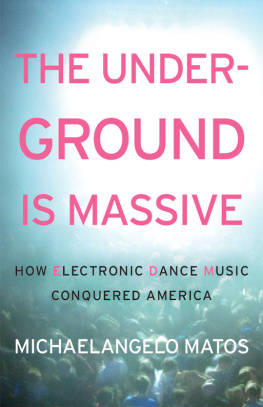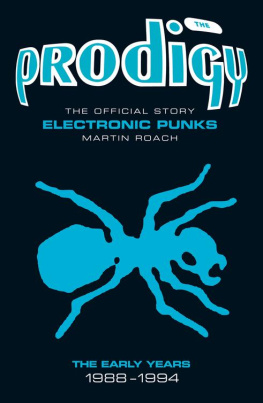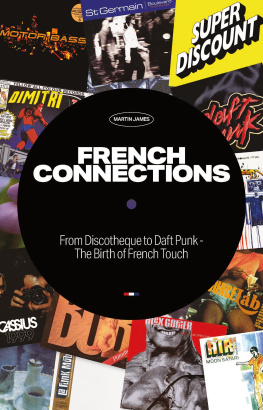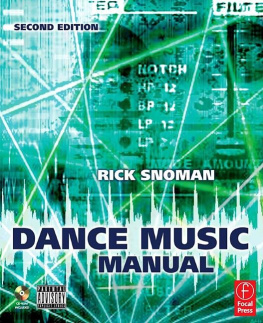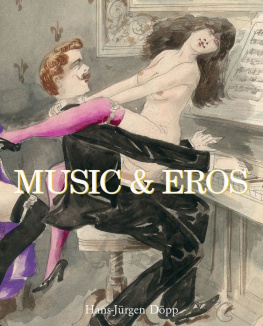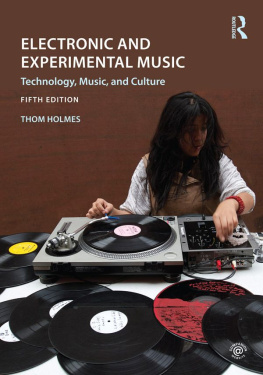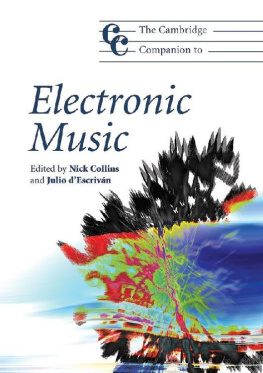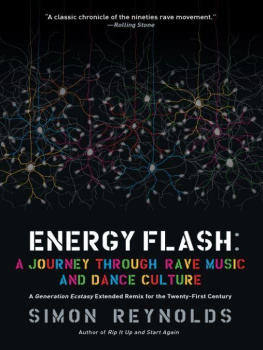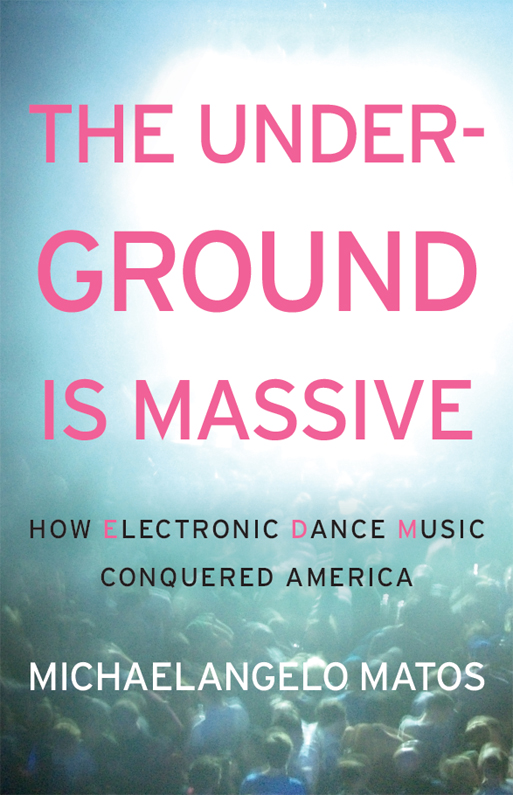Aint nothin goin on but history.
BASEMENT JAXX, RED ALERT (XL, 1999)
CONTENTS
Guide
LATE SUNDAY NIGHT on Memorial Day weekend 2013, outside of 1515 Broadway in Detroit, I was introduced to a DJ Id spoken with some weeks earlier over the phone about the citys electronic-dance-music history, its party scenesincluding specific partiesand its peccadilloes and controversies. Hed indulged me for two hours, but Id smelled an undercurrent, and in person it didnt take long to emerge. Why arent you going to focus on the hidden gems? he asked. Why are you talking all the obvious shit?
If only Id had the presence of mind to ask when he was going to play a two-hour set that included his entire record collection. The obvious shit to him is almost completely unknown to nearly everybody else in the country. When electronic dance music wasnt popular in the United States, we consumed it very differently than the rest of the world. Now that it dominates our concert businesswhich essentially is the music business nowwe still consume it differently than other countries. The Underground Is Massive is an attempt to understand how, and why, those things happened.
The book is not an expanded listicle of Greatest Parties Ever; a number of the events covered, not just the ones in the chapter titles, bombed. The loudest, in retrospect, may have been the World Party, at Joe Louis Arena on June 18, 1994the precursor to the utter triumph of the first Detroit Electronic Music Festival six years later. Glasgows Keith McIvor (Twitch; today, JD Twitch, half of Optimo), a huge fan of Detroit techno, was thrilled when he saw the lineup: We really believed we were going to be playing the best party in the history of the world. Instead, the arena reached less than five percent capacity. McIvor was dumbfounded when kids approached him after hed played some Detroit classics and asked: Where is that from? McIvor responded: Er... here.
Yet here has never been adequately documented in full. Here operates on a very different apparatus than the rest of the world. The book's subtitleHow Electronic Dance Music Conquered Americais deliberately chosen: This is a story about a culture forming, taking over every part of the world except its creators ownonly to rear up and take center stage after mutating into something its inventors barely recognized. Its also about people who took it to audiences it hadnt reached. To recount them all would take an encyclopedia; this book could have been many times larger with little effort.
Two things I knew going in: I wasnt writing a history of either Chicago house or Detroit techno. Each is a story for other books than this one. Nevertheless, there will be people who fault it for that before anythingfor overlooking the hidden gems in favor of a through line that has existed for decades, sometimes purely local, sometimes intersecting with the larger listening world. Hence, many major electronic dance careers are shortchanged in these pages, including those of people I spoke to at great length. So are entire movements, genres, scenes, and events that, with a shift of emphasis, could have been swapped out with many others here.
Then there were the many stories I couldnt crowbar in without necessitating entire new passages, or chapters. Just a few examples: Low End Theory, Daddy Kevs path-breaking L.A. club night, starting in 2006. Most of the history of Miamis Winter Music Conferenceloads of Florida history generally. The Boston scene, up to and including DJ/rupture, whose two-part mix Gold Teeth Thief (2001) is the most resonant post-9/11 recording I know by anyone. The infamous Raymond Frances, the East Coast mixtape king, and the RIAA-engineered raids on NYC and D.C. mixtape vendors in 1994. Huge swaths of New York house history. San Franciscos feminist party collective Your Sisters House, 19931994. The forty-five-hundred-word feature I wrote after following Minneapolis crew Family Werks around as they threw their Valentines Day 1999 party Love, which Id originally planned to drop into the narrative as is, just to give the flavor and specifics of the time and place. MTVs reality hit Jersey Shore (20092012), which brought house music into millions of homes via series lead DJ Pauly D. Metro Area and the reclaiming of disco. DFA Records generallyand Ninja Tune, Dust Traxx, Submerge/430 West, Asphodel, and Spinnin, just for starters. MUTEK 2002. Decibel Festival 2012. The 2013 Brooklyn Electronic Music Festival. A spring 2013 visit to an actual rave at Bedford-Stuyvesants Electric Warehouse in the midst of EDM-festival madnesstwo months before the venue was shut down by local authorities. Chicagos mid-nineties jungle scene. Illbient. And the 2014 Electric Zoo, manned by heavy security and police dogs, yet another harbingerin a season frighteningly full of themof the U.S. turning into a police state.
If youd told me at Winter Music Conference in 2000 that Id someday write a history of the music I loved, Id have raver-hugged you. If youd added that Id have to cut both Danny Tenaglia and Josh Winks Higher State of Consciousness out of it, Id have shanked you. Yet thats what it came down to here. Tenaglia is one of the dozen greatest DJs Ive ever heard; hes done as much to spread house music as anyone alive. He just did it away from the center of the events Ive focused on. Ditto the many names aboveand so many othersas well.
For what its worth, I attended precisely zero of the events for which the chapters are namedthough Ill also mention that the chapter configurations changed constantly through the books gestation; at one point or another about forty parties were mooted as chapters before I whittled it down to the eighteen in the book.
One defining dichotomy of dance music is that it is, by definition, populistand that many of its most ardent fans are anything but. Thats one reason we still deal with people who, every time a new genre emerges, insist that somebody just made up a name to hoodwink everybody, and never mind that if you cant tell jungle from house, you probably cant tell the Byrds from Slayer, either. The dance side sometimes gets anxious: Quit calling it something else, because people think its a fad anyway.
But America knows now what many of us have for decades: Electronic dance music is not a fad but a staple. Country stars use detonating dubstep bass. Pop and R&B and hip-hop radio are awash in synths that sound like they could have been on a Ministry of Sound compilation anytime in the late nineties or early 2000sand sometimes feature music that was. There are DJ-themed reality competition shows.
Maybe someday well get a book about EDM Babylon, a from-the-trenches report that treats the whole thing like a glitter parade and is full of salacious shenanigans from the lighting technicians. Hey, Ill read it. But while I didnt shy from dirt, that isnt the viewpoint of the story that follows. Its written from a fans perspective, as well as that of a journalist and critic whos been on a couple of junkets (both of which, in different ways, made their way into the text: the Red Bull Music Academy confab in Palm Springs, California, February 2011; and Tomorrowland, in Boom, Belgium, July 2013). But its not quite an insiders view. Ive never had the money to jet off to Berlin and stay up for three days while glimpsing the universe with my new best friends; nor have I done PR, started a label, attempted to spin (beyond just playing records like a college-radio DJ), produced or remixed a track, or written DJ bios. Within the ultra-DIY world of electronic dance music, this makes me an oddity; many of the people with the most to say in these pages wear many of those hats.

